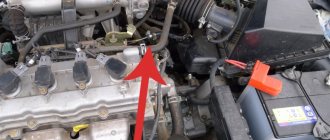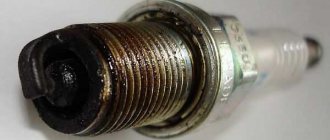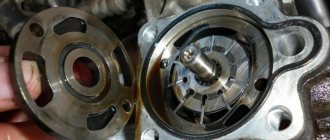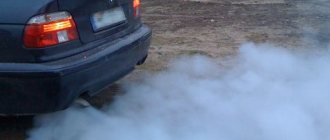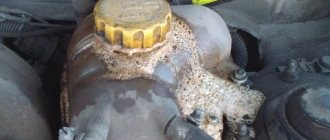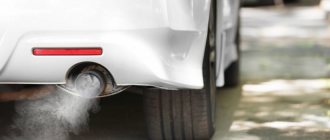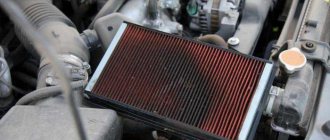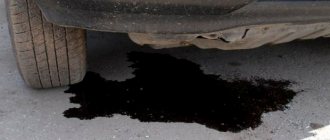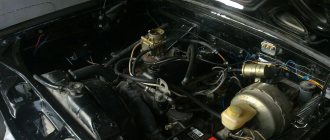Operation / From Autoclub
- The nature of smoke and the degree of wear of the power unit
- The main reasons for the appearance of blue smoke from a car muffler
Piston ring defects
- Violation of cylinder dimensions
- Cylinder defects
While the car is new, few people pay attention to the condition of the exhaust gases and think that problems can be determined by their color. However, over time, especially if you do not pay due attention to vehicle maintenance, a more experienced neighbor in the garage will tell you about the appearance of a non-standard exhaust. Knowing the reasons for this phenomenon will certainly help to avoid unpleasant moments in the future, especially when buying a used car. What useful information on the topic is contained in the article:
- The nature of the appearance of unusually colored exhausts
- The relationship between the appearance of smoke and wear of the power unit
- Overview of the reasons for the appearance of blue (gray) exhaust
- Piston ring defects
- Violation of cylinder dimensions
- Cylinder defects
- Non-standard fault options
- conclusions
The nature of the appearance of bluish smoke from a car exhaust pipe
An unusual color of exhaust gases always means that one of the vehicle's systems or components is faulty.
Based on simple observation, it is possible to determine the breakdown of a certain mechanism. If, for example, a white exhaust indicates the presence of coolant in the cylinders, and a black indicates a supersaturated mixture, then the main reason for blue smoke from the muffler is oil combustion in the internal combustion engine . This is where its name comes from - “oil”, which indicates serious problems with the engine.
At the same time, it must be taken into account that exhaust gases can have different shades, and this depends on many factors, including:
- degree of engine warm-up;
- composition and quality of motor oil;
- number of revolutions;
- external light conditions and ambient air humidity.
It is obvious to assume that “oily” exhaust is certainly accompanied by increased consumption of engine oil. This is actually true, for example, if at a standard consumption of 10 g per 100 km, blue smoke from the exhaust pipe appears only in transient modes, then exceeding the operating standards for oil consumption (ICE wear) will be expressed in the same way, only now in constant motion mode.
Repair
Repairs here cost a lot of money. As a rule, such breakdowns “come out” on very worn engines - and then you just have to “dig” and away you go. BUT, in essence, you need to change the rings, and also grind the surface of the cylinder (as motorists say, “to fill a mirror”), this does not always work out, and therefore sometimes the engine block itself is bored for pistons and rings of larger diameter. Watch a short but useful video about replacing rings.
Previously, 20 - 30 years ago, boring was a completely normal process, the oils were terrible then, and there was only one coolant - water. Therefore, the engines did not run for very long, and they were repaired. Now, in the era of synthetic oils and coolants, such types of work are forgotten; boring a block is now a very rare activity.
As you can see, repairs are quite complex and expensive, so it is better to properly care for your car. Use good oil, change it on time, and also monitor the coolant to avoid overheating. Then you can forget about blue smoke!
I’ll finish this, read our AUTOBLOG.
Similar news
- Speed sensor repair. Using the 2008 Chevrolet AVEO as an example
- Is it worth repairing the steering rack? What's the benefit?
- Do I need to change springs when replacing shock absorbers (struts). Sort it out...
Add a comment Cancel reply
The nature of smoke and the degree of wear of the power unit
Experienced specialists, based on their own observations or the client’s descriptions of the characteristics of smoke, can with a high degree of probability guess the nature of the problem. Let's look at a few common cases :
- If the blue-white exhaust appears only when the engine warms up and gradually disappears as it warms up, then there is no reason to fear serious wear of the mechanisms. This effect is explained by the ability of parts to expand; when heated, the gaps decrease and oil leakage stops.
- In the case when, after warming up the power unit, smoking not only continues, but also intensifies, it can be argued that there is significant wear of the internal combustion engine elements. The reason is the following - the expansion is not enough to reliably seal the gaps and through them hot oil easily penetrates into the cylinders.
It goes without saying that blue or blue-white smoke from the muffler is accompanied by increased oil consumption. Therefore, monitoring its level using a dipstick is a necessary operation, which makes it possible to determine a breakdown in the early stages of its occurrence. Exceeding the consumption rate of lubricants should immediately alert the owner. In addition, on modern cars, due to the fact that they are equipped with a neutralizer that can purify gases, it is not always possible to determine the color of the exhaust even with increased oil consumption.
We must not forget about such a phenomenon as compression, the degree of which can sometimes be misleading. So, at first glance, wear of the CPG elements is quite often characterized by loss of compression and increased crankcase gas pressure. However, at the same time, a significant amount of oil seals the gaps and if they are not very far from standard, then the compression gauge readings may be normal, and sometimes closer to the upper limit.
What to do if you detect dense white smoke
When disassembling the cylinders, it is necessary to analyze the condition of the spark plugs. The formation of scale on the candles indicates that water has gotten inside. After examining all cylinders and glow plugs located in them, it is necessary to repair or replace the cylinders and glow plugs. It is recommended that these measures be carried out with the help of qualified technicians at the nearest service station.
Often, low-quality coolants, when in contact with the working elements of the engine, cause increased corrosion of components and parts of the power unit. Cheap varieties of antifreeze can literally corrode the internal parts of the engine when leaks occur. After such an impact, it is not possible to repair damaged parts.
To ensure that the coolant penetrates into the combustion chamber, it is necessary to remove the cap from the expansion tank. A sharp burning smell, a decrease in the level of antifreeze in the tank, and a floating oil film indicate the detection of this defect.
The main reasons for the appearance of blue smoke from a car muffler
An owner who knows the slightest bit about how a car works knows that oil can get into the combustion chamber only in two ways:
- through piston rings;
- through the gap between the guide bushings and the valve stems.
From here we can already identify several groups of reasons why bluish smoke appears from the exhaust pipe and oil consumption increases:
- change in cylinder geometry;
- piston ring defects;
- scoring on the cylinder surface;
- wear of the oil seal;
- valve leakage.
Let's take a closer look at some of the reasons from the list above.
Piston ring defects
One of the most common reasons leading to excessive consumption of lubricant. Compression rings wear out not only on the outer planes, but also on the end planes due to the high gas pressure in the cylinder. Moreover, worn grooves of the structure can create a “pump” effect, i.e. pump oil directly into the cylinder, even if the oil scraper rings are fully functional.
Violation of cylinder dimensions
Cylinders often wear out where the top ring stops when the piston reaches TDC. Also in the middle region of the cylinder, changes in its geometry towards an ellipse are observed. When carrying out diagnostics, it is important to accurately determine all deviations of the cylinder from the circle; this is the only way to get rid of the fact that blue smoke is coming from the muffler and excessive oil consumption is noticed. To do this, a series of independent measurements are made:
- in two vertical planes of the cylinder;
- in four levels horizontally of the node.
Cylinder defects
Unpleasant things like scuffs and scratches on the cylinder bore also allow oil to penetrate. The causes of such defects may be:
- abrasive particles due to unsatisfactory filtration of the lubricant;
- long-term parking of the car, as a result of which corrosion may occur on the rings and cylinders;
- non-compliance with power plant repair technology and the use of low-quality parts.
Reasons for failure of oil scraper rings
There are several reasons, I will list them point by point:
1) Poor quality oil. The whole point is that if you use low-quality materials to lubricate the engine or those that are not prescribed by the manufacturer. This can cause increased wear of parts, especially rings. They will quickly wear off and begin to leak oil.
2) Untimely oil change. It’s similar to the first point, but here the oil loses its properties due to high mileage, which can also cause a lot of wear.
3) Engine overheating. If you overheat the engine, the temperature rises above a critical level, then engine parts may become deformed from high temperatures. Oil rings are no exception to this.
4) Incorrect assembly during repair. Incorrectly installed rings during engine overhaul may also be the cause.
5) If the car has not been used for a long time, then it may simply rust and “pockets” of corrosion may appear on the rings, through which oil will also pass.
Non-standard fault options
When it comes to turbocharged engines , symptoms of discoloration of the exhaust may be associated with wear on the compressor rotor seals and bearings . At the same time, a defect in the seal of the front bearing of the turbocharger gives a characteristic picture, which is similar in external factors to wear of oil seals, including carbon deposits on the spark plugs. It is somewhat more difficult to determine the failure of the turbine seal due to the direct entry of oil into the exhaust system, where it burns out.
Quite rarely, but still occurs, a malfunction of the automatic transmission regulator membrane (if there is a vacuum load sensor). This also leads to a phenomenon such as blue smoke from the exhaust pipe; the defect can be determined by the condition of the spark plugs, which are filled with oil, as well as the splashing of lubricant from the spark plug mounting holes. Box oil has a reddish color and a specific smell - this is what will help diagnose a breakdown.
Causes of engine smoking
The list of main faults that cause increased smoke formation includes:
- problems with the fuel supply system;
- wear of the cylinder-piston group;
- malfunctions of the gas distribution mechanism;
- malfunctions of the engine cooling system;
The appearance of smoke can be caused by incomplete combustion of the fuel-air mixture, failures in the combustion process, or the ingress of coolant from the cooling system or engine oil from the lubrication system into the combustion chamber. These faults can color the exhaust gases a certain color.
As an example, consider the ineffective operation of the engine cooling system. Insufficient cooling leads to engine overheating and destruction of the piston rings. Problems with the rings mean that oil starts getting into the cylinders and the engine smokes.
Eventually
Operating a car with blue exhaust is not only uncomfortable for those around you and passengers, but is also extremely detrimental to the components of the car. Therefore, at the first sign of an atypical exhaust, you should analyze the situation yourself or contact a specialist.
The reason should be sought in components that are actively in contact with oil, and this is, first of all, the cylinder-piston group, automatic transmission with a vacuum load sensor, and also the turbocharger.
Causes of transmission oil leaks and ways to eliminate them
What is engine detonation and what are the causes of its occurrence?
Smoke with a bluish (gray) tint
If a diesel or gasoline engine smokes heavily with blue gas, this means that engine oil is leaking into one or more cylinders. During combustion, thick clouds of smoke are formed, which have a persistent smell of burnt oil and do not dissipate for a long time.
Depending on the type of motor oil used and the ambient temperature conditions, the color of the smoke may have different intensities of blue. To give a more accurate assessment of the nature of the smoke coming out and distinguish it from standard exhaust, it is necessary to regularly check the oil level. Excessive consumption of machine lubricant indicates the presence of leaks.

